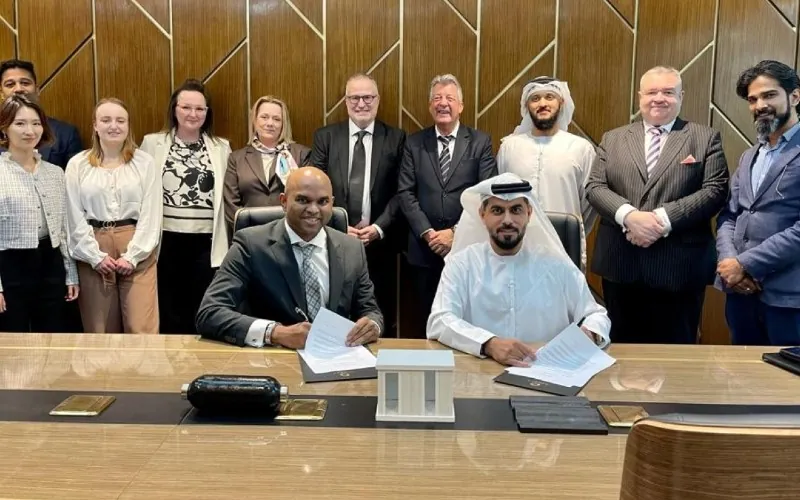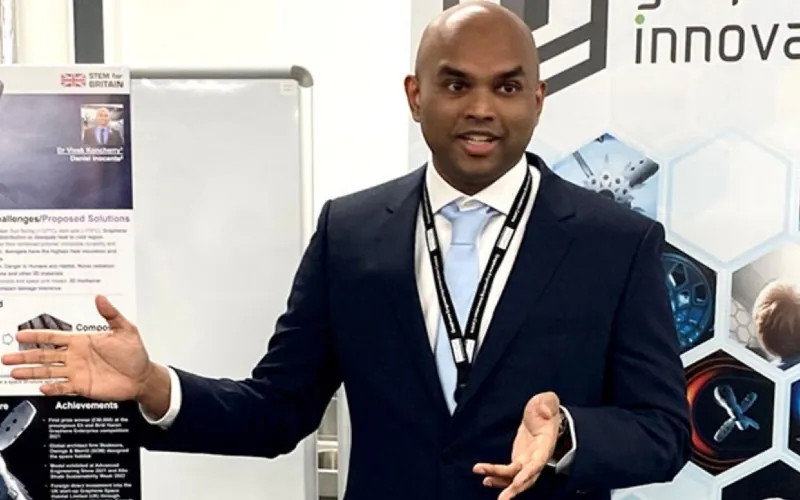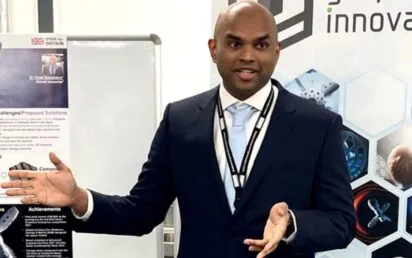If you haven’t already heard of the name Dr Vivek Koncherry, you will soon.
He’s the CEO of Graphene Innovations Manchester, which connects graphene technology with business opportunities on a global scale.
Last year he signed a $1 billion game-changing partnership deal with Quazar Investment Company to create a new company in the UAE to help tackle global sustainability challenges.
He’s already been described as Manchester’s answer to Elon Musk – and last week wowed judges to win the North West heat of KPMG’s Tech Innovator in the UK 2024.
Koncherry recently spoke at the launch event for BusinessCloud’s GM 125 Rising Stars of Business list, which was run in conjunction with GM Business Growth Hub.
So who is Dr Vivek Koncherry and why the comparison with Musk?
James Baker is the CEO of Graphene@Manchester. It was he who coined the reference.
Baker is is responsible within the University of Manchester for commercialising graphene and 2D materials for products working with industry.
He said: “Vivek is one of our great finds. He’s alumni from the university, he’s been a PhD, he’s been a post doctoral researcher but, more than that, he’s an entrepreneur and an inventor.
“He’s not only got one business, he’s got four businesses, going towards his first billion-dollar business.
“He’s probably the Elon Musk of Manchester. Let me give you one silly story about Vivek.
“He developed something called plastic concrete or water-free, cement-free concrete.
“He showed me that on a Monday. Whilst I liked it, I commented it was bit ‘plasticky’. By the Tuesday he showed me one that looked like cement.
“I said ‘that’s really good but why can’t we have a red one for roads, a blue one for cycle paths and a yellow one for walkways?’ On the Wednesday there was blue one, a yellow one and a red one!
“I said ‘why can’t we have one that changes colour’. I went in the following day and it was changing colour under a hairdryer. Imagine a road that was green during the day but when it was frosty it turned red so you know it’s icy.
“They’ve all got graphene from plastic waste. He’s taking waste material and turning it into a valuable product.”
Graphene was famously discovered in 2004 by Prof Andre Geim and Prof Kostya Novoselov at The University of Manchester.
Now Koncherry, who is originally from a village in the Indian state of Kerala, is on a mission to use graphene to tackle global problems.

Dr Vivek Koncherry signs $1 billion game-changing partnership deal with Quazar Investment Company
His family in India made flooring and carpets from natural products like coconut fibre but his father also loved to make electronic devices.
His young son quickly showed a talent for innovation and in 2001 went to The University of Manchester to take a degree in textile, technology and management.
This was quickly followed by doing a PhD sponsored by Bentley and then he got a project from the Government’s Defence Science and Technology Laboratory (DSTL) in materials.
Today he’s the CEO of Graphene Innovations Manchester, which is the biggest tenant based at Manchester Graphene Centre.
He said: “We are a sustainable graphene product development company established to solve global problems like climate change, water shortages, pollution etc.
“To solve these problems we use AI, robotics and graphene. That’s how we develop the new technology.”
One of the products that impressed judges at KPMG’s Tech Innovator in the UK 2024 was graphene-enhanced concrete that does not need cement or water and can be made using recycled materials.
Koncherry explained: “In the materials world, graphene is still a new material. Most of the materials we use today, like carbon fibre, have existed for 50 or 60 years, while steel has been around for hundreds of years.
“Graphene is fairly new and it’s one of the advanced materials. It’s the material which is a million times smaller than 1mm!
“It can be used in so many applications. For example you can add a small amount of graphene into concrete to make the concrete stronger. You can use less materials, reduce cost and cut CO2 emissions.
“You can use graphene in desalination to separate salt from water or you can use it in semi-conductors to conduct heat.”
Since it discovered, graphene has been used in a variety of applications – but Koncherry said one of the biggest challenges remains investment.
“Manchester is the best place for innovation, there’s no doubt about it,” he said. “The biggest problem I’m facing is commercialising it. There’s a big gap in funding.
“For example, I’ve developed a product. It’s so easy for me to raise funding in the Middle East, US or Canada but when it comes to Manchester, I’m really struggling. It’s not just me, I know a lot of my other CEOs have experienced something similar. We are moving outside to get the funding.
“Even in the graphene sector, where I’m based, I know many startups there that are going outside to get funding. A lot of people don’t want to take (a) risk here. They’re risk-averse. That is a big problem at the moment.”


